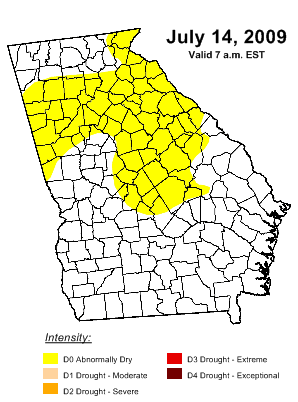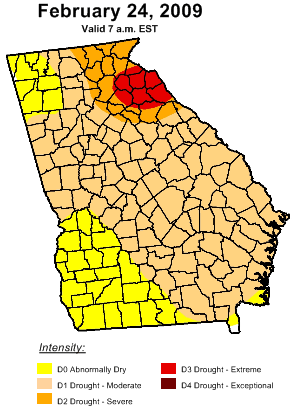Widespread March rainfall has caused all but a few North Georgia counties to become drought free. According to information from Georgia Climatologist David Stooksbury, the only counties still considered to be in moderate drought are Union, Towns, Rabun, Lumpkin, White, Habersham, Hall and Stephens. A few northwest Georgia counties are drought free, while the remainder, including Gwinnett, are classified as abnormally dry, mostly due to the long-term rain deficit we’ve experienced for the past four years.
Atlanta has recorded 7.12 inches of rain in March, over two inches more than normal. For the year, the deficit is 1.09 inches. With 7.03 inches of March rain in Athens, the Classic City is only .39 inches below normal for the year. With an additional inch or so expected Tuesday through Thursday, both cities could be back to normal rainfall by the end of the week.
While the plentiful precipitation seems to have encouraged Atlanta area flora to show their spring colors more strongly than in recent years, the hidden subtext of the drought picture, which I assume will be reflected in Thursday’s drought monitor, is that the counties that make up Lake Lanier’s drainage basin, including Hall and Habersham, are still in a moderate drought. Last week’s rainfall raised Lanier’s level by over a foot, but the lake is still ten feet below full summer pool.
The current climate pattern of a weak La Nina transitioning to neutral is responsible for much of the changes to a wetter spring. According to Stooksbury:
Currently the climate pattern is a weak La Niña pattern tending toward a neutral pattern. A typical weak La Niña spring brings wet weather across the northern piedmont into the mountains, just like north Georgia experienced in March.
Moisture conditions are in good shape across most of the state’s northern half, but the typical moisture recharge period will be ending soon. By the middle of April, plants are in full spring growth and using tremendous amounts of water.
By the middle of April we can expect the soils to begin to dry because of increased plant water use. Additionally, by the middle of April, temperatures are routinely in the 70s to low 80s. This means that evaporation will increase. This late spring and summer drying is normal.
The outlook is for a few more weeks of recharge followed by the normal drying of the soils due to plant water use and evaporation. May is usually a dry month. Little recharge is expected from May through October, but this is typical for Georgia.
The big unknown is what the tropics will bring Georgia this summer and winter. Much of the state’s late summer and fall rain comes from tropical disturbances. Without moisture from the tropics, August through October can be very dry. At this time there are no clear indications of how much rainfall the summer will bring.
Sphere: Related Content
 The latest drought report, as of July 14th, lists just over one third of the state of Georgia as being abnormally dry, including metro Atlanta and Gwinnett. This is despite the one to three inches of rain that fell on Sunday. While this may seem ominous, keep in mind that a year ago over half the state was in a severe drought.
The latest drought report, as of July 14th, lists just over one third of the state of Georgia as being abnormally dry, including metro Atlanta and Gwinnett. This is despite the one to three inches of rain that fell on Sunday. While this may seem ominous, keep in mind that a year ago over half the state was in a severe drought.

 As far as the weather goes, winter is almost over, and with it, the best chance for reducing Georgia’s long-term drought. However, looking at the rainfall we’ve had for the first two months of the year, we are woefully behind where we should be. As of this morning, we’ve had 4.39 inches of rain in Lawrenceville, compared to a normal of 9.19 inches, or 48%. Atlanta is doing even worse, with only 3.84 inches, or 42% of normal rainfall.
As far as the weather goes, winter is almost over, and with it, the best chance for reducing Georgia’s long-term drought. However, looking at the rainfall we’ve had for the first two months of the year, we are woefully behind where we should be. As of this morning, we’ve had 4.39 inches of rain in Lawrenceville, compared to a normal of 9.19 inches, or 48%. Atlanta is doing even worse, with only 3.84 inches, or 42% of normal rainfall.